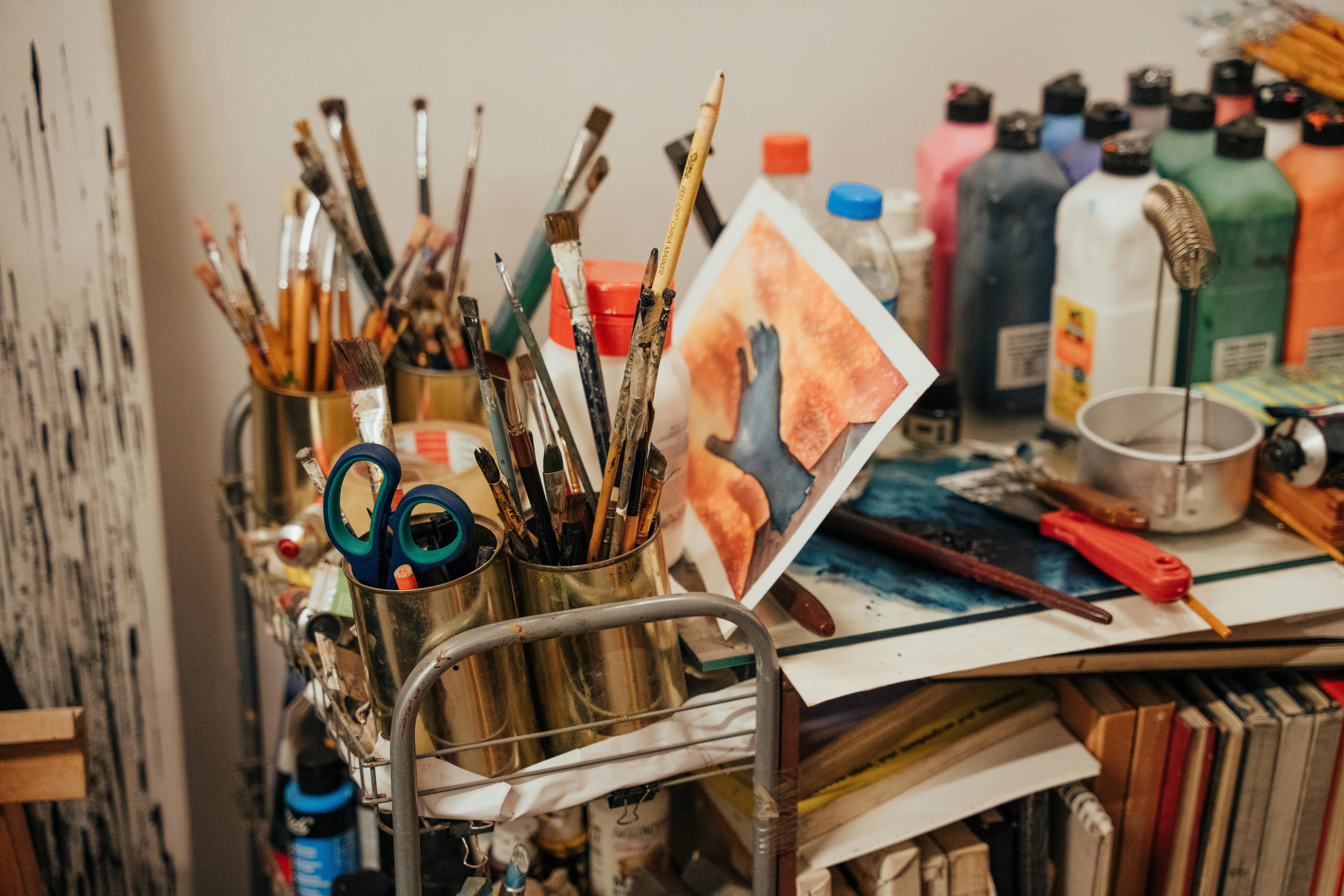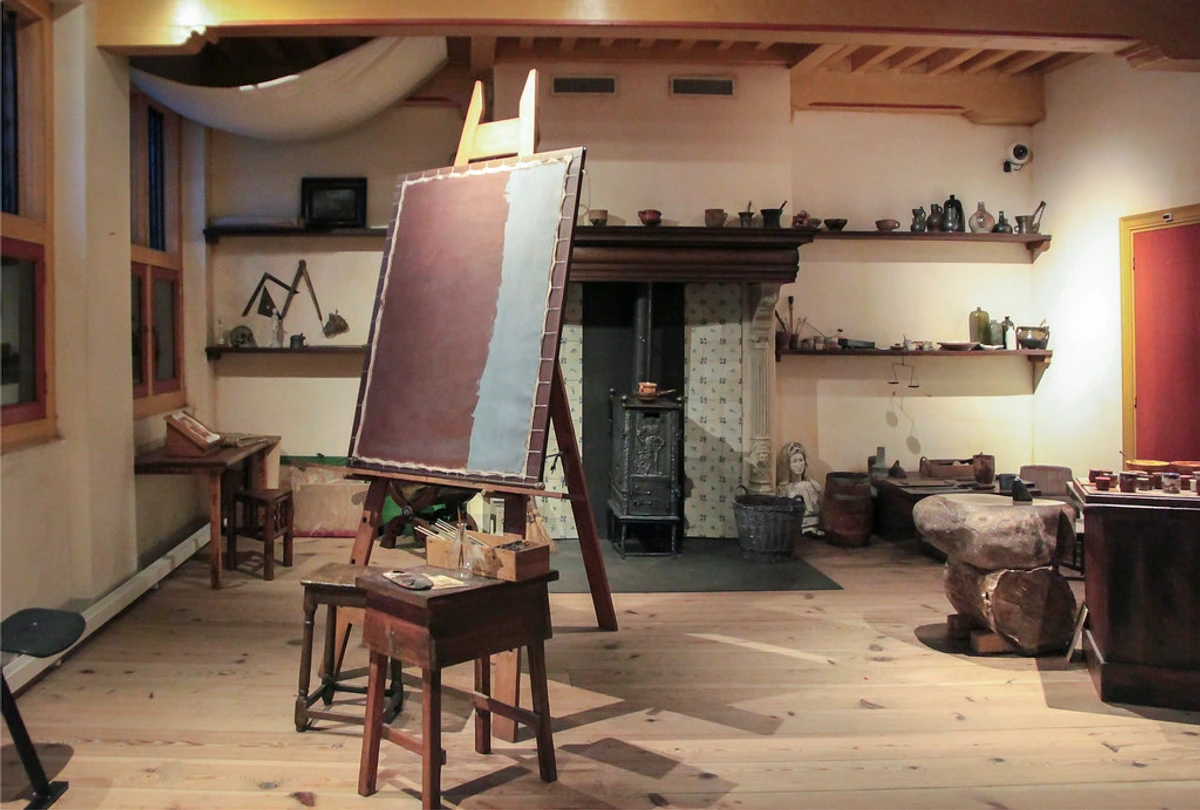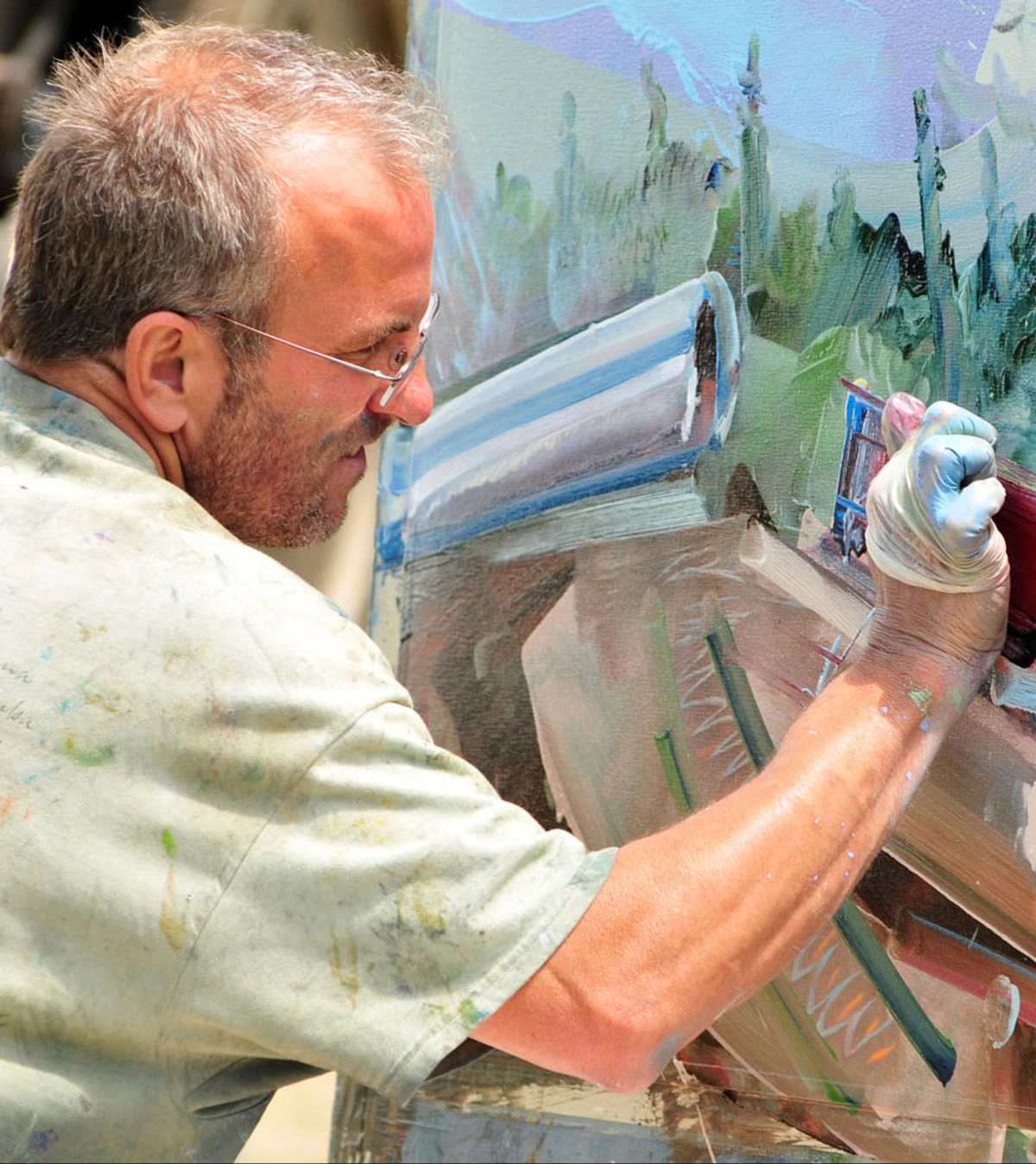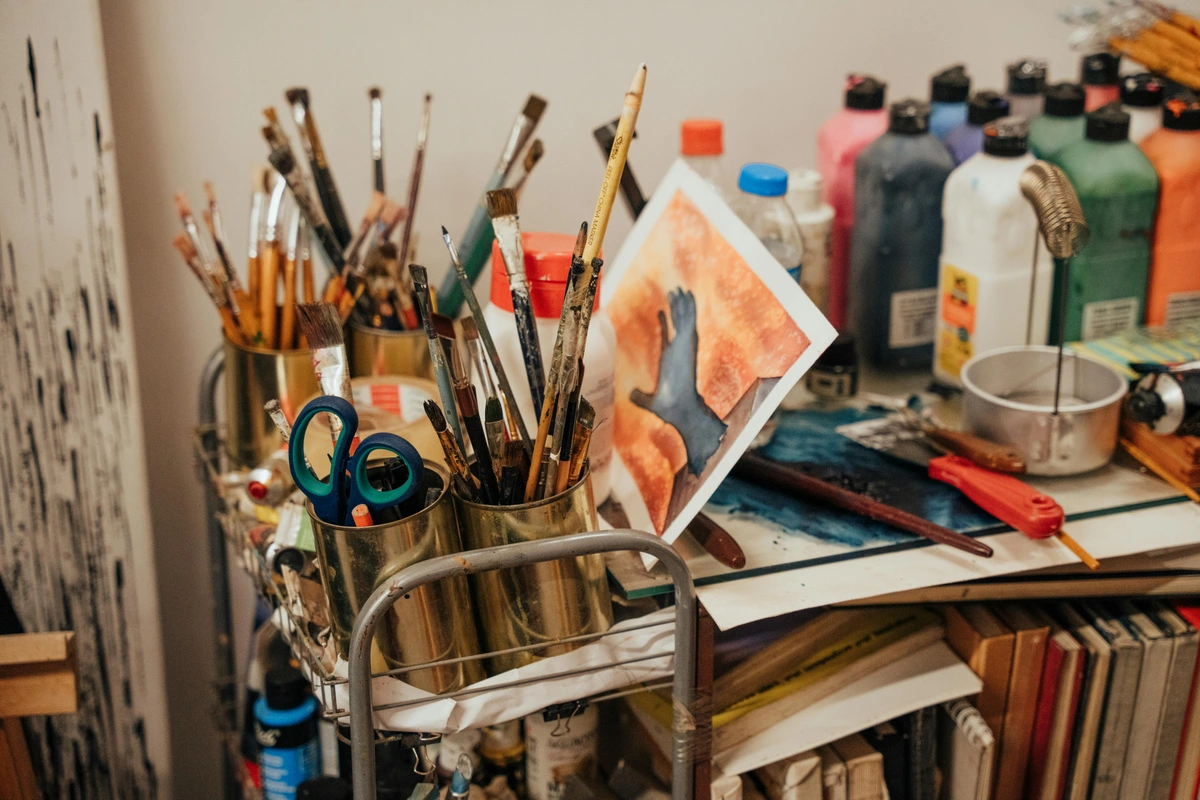
Oil Painting's Enduring Alchemy: A Personal Journey Through Art History
Join an artist's intimate exploration of oil painting's rich history, from prehistoric origins and alchemical refinements to Renaissance mastery and modern abstract expressions. Discover its enduring magic and personal resonance.
The Enduring Alchemy of Oil: A Personal Artist's Journey Through History
Sometimes, when I'm standing in my studio, surrounded by tubes of paint and the comforting scent of linseed oil, I pause. It's not just a momentary lapse in concentration, though let's be honest, that happens more often than I'd like. Instead, I'm struck by the immense weight of history in my hands. It’s a thought that always stops me in my tracks, really. That the very medium I use to express my chaotic, colorful inner world has journeyed from prehistoric cave walls, where artists mixed ochres and charcoal with animal fat, and alchemists' workshops to this little corner of 's-Hertogenbosch. It's this deep connection to the past that often fuels my present.
My journey as an artist has often felt like a series of happy accidents and stubborn experiments, much like the evolution of art itself. Today, I want to invite you on a grander expedition, a personal exploration through the remarkable history of oil painting, from its surprising and ancient origins to its enduring mastery in the modern world. It’s a tale of innovation, patience, and a little bit of magic.

Before the Oils: A Glimpse into Ancient Artistry
But before oil paints graced the canvases of the Renaissance, what tools and techniques did artists employ to bring their visions to life? For millennia, they relied on mediums like fresco, painting directly onto wet plaster, or tempera, using egg yolk as a binder – the substance that holds pigment particles together and allows them to adhere to a surface. Tempera, while offering incredible detail, dried quickly and unforgivingly. This rapid drying time, combined with its tendency to crack if applied too thickly, necessitated those crisp, linear styles and meticulous brushwork we see in so much early European art. Imagine the sheer speed required for fresco – no time for second guesses, no luxurious blending; it makes me think of trying to make a perfectly blended coffee in a hurry, only to realize I've just stirred water. Tempera was often applied to rigid wooden panels prepared with gesso (a white ground), which, while providing a smooth surface, could also exacerbate cracking if the paint layers were too substantial. Other methods included encaustic, where pigments were mixed with heated beeswax, offering vibrant colors but demanding quick application. We also find evidence of distemper, using animal glues as binders, and early forms of varnishing with natural resins to protect and enhance surfaces. It's a stark reminder of how much technology (even in art supplies) shapes what's possible.
I often think about those early artists, grinding their own pigments from minerals (like lapis lazuli for blue), plants, and even insects (cochineal for red), often using a heavy muller on a stone slab. It sounds utterly exhausting, doesn't it? A bit like trying to build an IKEA dresser with only a butter knife and a vague sense of existential dread. Nowadays, I just squeeze a tube, and voilà! Instant color. It makes me appreciate the simple luxury of pre-mixed paints and the countless hours those pioneers saved for us, allowing us to delve into the history of art with such rich examples.
And the story of oil isn't strictly European, nor is it as recent as commonly perceived. Beyond its artistic applications, oils were used in ancient Mesopotamia as sealants for boats and buildings, and in ancient Egypt, plant oils mixed with pigments served purposes from cosmetics to tomb decoration and even embalming. These practical, early applications hint at a much deeper, widespread understanding of oil's binding and protective qualities. But perhaps most astonishing to many, including myself, is the evidence from 7th-century Buddhist cave paintings in Afghanistan, such as those found in Bamiyan, which show early oil-based mediums used with walnut and poppy seed oils to create vivid colors and depictions of Buddhas and bodhisattvas. This fact still astounds me – the sheer geographic and cultural spread of artistic innovation predates the commonly cited European origins by centuries. These early applications, while not as refined as later European techniques, clearly demonstrated oil's potential to bind and enhance pigments. It’s a quiet testament to human ingenuity stretching across continents and millennia, a prelude to the revolution yet to come. These early methods, while ingenious, paved the way for a medium that would truly revolutionize artistic expression.
To better illustrate the evolution of artistic mediums, here's a quick comparison of these early techniques:
Medium | Binder | Characteristics | Challenges in Painting Process |
|---|---|---|---|
| Fresco | Wet plaster | Luminous, durable, integrated with wall | Extremely fast drying, no corrections |
| Tempera | Egg yolk | Precise detail, crisp lines, matte finish | Very fast drying, limited blending |
| Encaustic | Heated beeswax | Vibrant colors, rich texture, durable | Demanded quick application, heat control |
| Distemper | Animal glue | Matte finish, good opacity | Not water-resistant, less durable |
The Northern Alchemists: Jan van Eyck and the Oil Revolution
So, if earlier forms of oil painting existed, what made the 15th-century Northern European revolution so profound? Now, for the truly transformative period in oil painting's history. While the Afghan discoveries are fascinating precursors, it was in 15th-century Northern Europe that oil painting truly blossomed into the sophisticated medium we know today. And no discussion of this period is complete without mentioning the legendary Jan van Eyck and his contemporaries.
Northern Renaissance masters like Van Eyck, Robert Campin, and Rogier van der Weyden are often credited not just with using oil, but with meticulously refining the medium itself. They experimented with different oils, such as linseed, walnut, and poppy, purifying them by washing them with water or allowing them to sun-thicken, which reduced yellowing and improved handling. Each oil offered distinct properties: linseed oil provided a durable film and relatively fast drying but could yellow; walnut oil offered a slightly slower drying time and less yellowing; and poppy seed oil was prized for its very slow drying and minimal yellowing, ideal for delicate whites and blues. This mastery allowed for sophisticated techniques that truly harnessed the unique properties of oil paint. Unlike tempera, which dried rapidly to a matte finish, oil allowed for remarkably slow drying times. This gave artists unprecedented control, enabling them to blend colors seamlessly, achieve subtle gradations of tone, and create incredibly luminous surfaces through glazing – applying thin, translucent layers of paint over opaque ones. The magic of glazing, as seen in the shimmering fabrics and lifelike skin tones of Van Eyck's Arnolfini Portrait, lies in how light penetrates these transparent layers, reflects off the opaque base, and then travels back through the color films, creating a depth and glow almost impossible to achieve otherwise. They could also use techniques like scumbling, where thin, broken layers of opaque or semi-opaque color were brushed over another color to subtly modify it, or build up textures with early forms of impasto, applying paint thickly to create a raised surface.
This meant unprecedented depth, rich saturation of color, and the ability to capture minute details in a way previously unimaginable. Imagine the meticulousness required for Van Eyck's iconic textures, from the shimmer of silk to the glint in an eye. It wasn't just about paint; it was about light itself, captured and manipulated on canvas. I often try to replicate that luminous effect in my own abstract artistic style, a testament to how these ancient methods still resonate. These innovations profoundly changed what was possible in portraiture, religious scenes, and still life, laying the groundwork for centuries of artistic development. For more on this pivotal era, you might find our ultimate guide to Renaissance art insightful.

From Flanders to Florence: Oil Painting Conquers Italy
But how did these revolutionary techniques make their way south, and how long could such a transformative medium remain confined to the North? The innovations of the North didn't stay confined to Flanders for long. By the late 15th and early 16th centuries, the secrets of oil painting began to travel south, influencing the great masters of the Italian Renaissance. Initially, Italian artists, deeply rooted in the traditions of fast-drying fresco and tempera, viewed the slow-drying oil medium with skepticism, sometimes even trying to apply it as if it were tempera. I can almost imagine the frustration, like trying to bake a soufflé using a microwave – a perfectly logical approach in their established context, but ultimately doomed. However, the undeniable advantages – its luminosity, blendability, and ability to render both fine detail and broad strokes – soon won them over. The medium's versatility made it perfect for the evolving ambitions of Renaissance art.
Artists like Leonardo da Vinci and Titian eagerly adopted and adapted the oil medium, pushing its boundaries even further. Leonardo famously utilized sfumato, a soft, hazy blurring of lines and colors, which was perfectly suited to oil's blendability, creating the enigmatic smiles and atmospheric depths seen in masterpieces like the Mona Lisa. Beyond sfumato, oil allowed for unparalleled chiaroscuro, the dramatic use of light and shadow to create volume and depth, and convincing atmospheric perspective, rendering distant objects with subtle shifts in color and tone. These capabilities profoundly impacted genres like highly detailed portraiture, vibrant still life, and expansive landscapes, which truly blossomed with the new medium. The Venetian School, with artists like Titian (Venus of Urbino showcasing rich color and texture), Giorgione, and later Veronese and Tintoretto, took the luminosity of oil to new heights, developing a distinctive use of color and light. They famously prioritized colore (color) over disegno (drawing), painting directly onto the canvas with rich layers and visible brushwork, creating vibrant, saturated palettes and capturing the unique play of light on surfaces that still mesmerizes. This cross-pollination of ideas cemented oil painting's place as the dominant medium across Europe, influencing countless famous paintings and defining the look of all art styles for centuries to come, from the dramatic chiaroscuro of the Baroque era, the delicate pastels of Rococo, the emotional narratives of Romanticism, to the stark realities of Realism.

The Modern Canvas: Tubes, En Plein Air, and Abstract Expressions
As the centuries turned, how did oil painting continue to adapt and transform, pushing the boundaries of artistic expression? From those early experiments and grand adaptations, oil painting continued its evolution. The development of pre-packaged pigments in tubes during the 19th century democratized the medium, freeing artists from the arduous task of grinding their own colors. Suddenly, painting outdoors (en plein air) became not just feasible, but a foundational practice for movements like Impressionism and Post-Impressionism. The slow drying times of oil paint were no longer a limitation but an advantage, perfectly suited for capturing fleeting moments of light and atmosphere, broken brushstrokes, and vibrant color mixtures characteristic of these movements. This was a liberation, allowing artists to truly engage with the world outside the studio, as beautifully explored in what is plein air painting.

The 20th century further diversified the oil painter's toolkit. The advent of synthetic pigments brought an explosion of new, stable colors, such as vibrant quinacridones (like Quinacridone Magenta) and phthalos (like Phthalo Blue), while innovative mediums and additives (like alkyd resins for faster drying, cold wax mediums for matte texture, or gel mediums for increased body and impasto) offered even greater control over paint's properties. The evolution of brush technology, from traditional hog bristles to versatile synthetic filaments, also profoundly impacted application techniques, allowing for a wider range of expressive marks. Post-war abstraction, particularly movements like Abstract Expressionism, found in oil's versatility the ideal vehicle for bold, gestural, and highly textured expressions of inner emotion. Artists like Jackson Pollock, with his revolutionary drip paintings using thinned oils, or Willem de Kooning, with his raw, impasto-laden figures, pushed the medium beyond traditional applications.
Even today, working with oils comes with its own quirks. While their slow drying times are a blessing for blending, they demand patience. I often find myself taking a deep breath and reminding myself that good things come to those who wait, especially when I'm wrestling with a particularly stubborn layer. Beyond proper ventilation for solvents (like turpentine or mineral spirits), which are crucial for thinning oil paint to achieve different consistencies and for meticulous cleaning of brushes and tools, artists must also consider yellowing over time. This is primarily caused by the oxidation of fatty acids, particularly in linseed oil, leading to a golden-brown tint. Artists often counteract this by using poppy or walnut oils for whites and blues, or applying archival varnishes. The importance of priming canvases or panels is also paramount; priming with gesso (an acrylic emulsion or traditional glue-chalk mixture) creates a barrier that protects the canvas from the oil's acidity, ensures proper adhesion, and provides a uniform, slightly absorbent surface. Finally, selecting the right support – be it linen, cotton, or wood – is key. Linen offers strength and a fine weave; cotton is more economical with a uniform texture; wood panels provide rigid, smooth surfaces suitable for fine detail. For me, these are not inconveniences; they are part of the medium's meditative ritual. My own approach to how artists use color is deeply rooted in this lineage, though often expressed abstractly.
Historical techniques like layering, glazing, and impasto are not forgotten; they are continuously reinterpreted. For instance, the luminous quality achieved by Renaissance glazes can inspire subtle veils of transparent color in my abstract work, while the bold, visible brushstrokes of the Venetian masters echo in my textured surfaces, as I often discuss when exploring texture in abstract art or my palette knife techniques. And it's this very lineage, this constant evolution, that I find myself wrestling with and celebrating on my own canvases today.
In a world brimming with digital art and fleeting trends, oil painting retains a unique, tangible appeal. Its rich history, tactile nature, and profound expressive capabilities continue to draw artists and collectors alike, making it as relevant today as it was in the Renaissance. For contemporary artists, myself included, it remains a medium of profound depth, capable of conveying nuanced emotion and creating lasting works.

The Echo of Centuries: Oil's Enduring Legacy
Today, standing in my studio in 's-Hertogenbosch, the echo of those ancient artists and Renaissance masters feels surprisingly close. The tactile pleasure of the brush on canvas, the slow alchemy of pigment and oil – these are timeless experiences. The medium may have evolved, the pigments may be pre-mixed, and the subjects often abstract, but the fundamental magic remains. It's a continuous dialogue between past innovations and contemporary visions, a heritage I actively carry forward in every stroke. Just as Van Eyck layered glazes for luminosity, I might layer transparent abstract forms to create depth; just as Titian used bold brushstrokes, I use a palette knife to build textured surfaces that resonate with similar energy.
It’s a reminder that art, like life, is a continuous unfolding, built upon the discoveries and experiments of those who came before. Perhaps that's why I find such profound satisfaction in my work – knowing that every stroke connects me to a lineage stretching back through centuries. This journey through history is not just an academic exercise; it's a profound source of inspiration for my own abstract artistic style. The future of oil painting, I believe, lies in this constant dialogue between past innovations and contemporary visions.
If you're curious to see how this rich tradition informs my contemporary creations, I invite you to delve deeper into my process on my timeline or perhaps explore my abstract art for sale. You can also experience the tangible connection to this legacy firsthand by visiting my Den Bosch museum here in 's-Hertogenbosch. The saga, after all, continues on my modern canvas.




